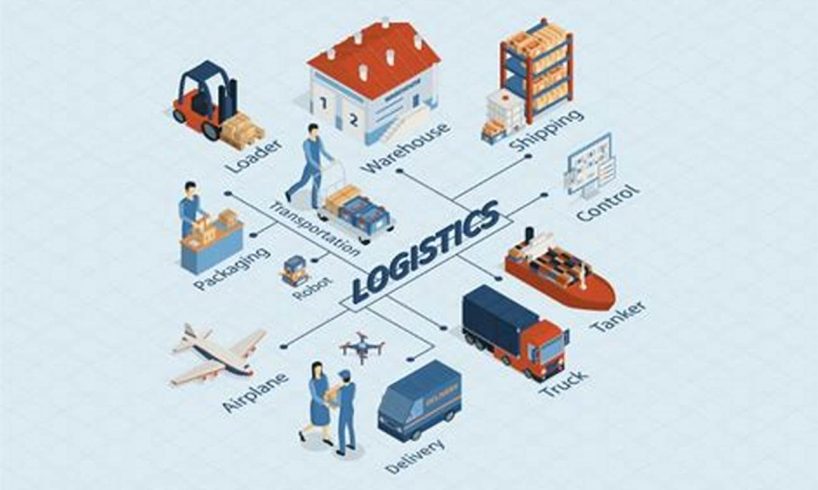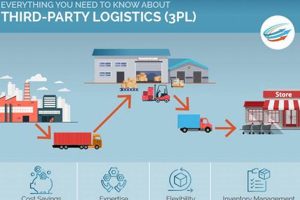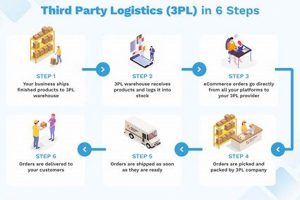
Service logistics is the management of resources and activities involved in delivering services to customers. It encompasses the planning, organization, and control of the flow of goods, information, and people within a service system. Unlike product logistics, which focuses on the physical movement of goods, service logistics emphasizes the coordination and delivery of intangible services such as consulting, healthcare, education, and financial services.
Effective service logistics is crucial for businesses to achieve customer satisfaction, optimize resource utilization, and gain a competitive advantage. It ensures that services are delivered efficiently, effectively, and in accordance with customer requirements. Service logistics also plays a vital role in managing capacity, inventory, and transportation, enabling businesses to respond quickly to changing market demands.
Service logistics has evolved significantly over the years, driven by advancements in technology, globalization, and the increasing demand for customized services. Today, service logistics professionals leverage sophisticated software systems, data analytics, and supply chain management techniques to optimize service delivery and enhance customer experiences.
1. Planning
Planning is a critical aspect of service logistics, as it sets the foundation for efficient and effective service delivery. It involves understanding customer requirements, forecasting demand, and allocating resources accordingly. Effective planning enables businesses to anticipate future needs, optimize resource utilization, and proactively address potential challenges.
One of the key elements of planning in service logistics is demand forecasting. Accurate demand forecasting helps businesses determine the level of resources required to meet customer demand, ensuring that services are delivered without disruptions or delays. For instance, a healthcare provider may use historical data and predictive analytics to forecast patient demand for various services, such as doctor consultations, surgeries, and diagnostic tests. This information can then be used to plan staffing levels, schedule appointments, and allocate medical supplies accordingly.
Another important aspect of planning in service logistics is capacity planning. Capacity planning involves determining the maximum level of service that a business can deliver with its available resources. This includes assessing the number of staff, equipment, and facilities required to meet customer demand while maintaining desired service levels. Effective capacity planning helps businesses avoid overbooking or underutilizing resources, ensuring that services are delivered reliably and efficiently.
Overall, planning plays a vital role in service logistics by enabling businesses to anticipate future needs, allocate resources effectively, and proactively address challenges. By investing in robust planning processes, businesses can improve service quality, reduce costs, and gain a competitive advantage.
2. Organization
Organization is a fundamental aspect of service logistics, as it establishes the structure and processes necessary for efficient and effective service delivery. It involves defining clear roles and responsibilities, establishing communication channels, and implementing systems to manage the flow of information, resources, and activities.
Effective organization in service logistics ensures that all stakeholders, including employees, customers, and suppliers, have a clear understanding of their roles and responsibilities. This clarity helps to avoid confusion, duplication of effort, and delays in service delivery. For instance, in a healthcare setting, well-defined roles and responsibilities for doctors, nurses, and administrative staff ensure that patients receive timely and appropriate care.
Communication channels are essential for smooth coordination and collaboration among stakeholders in service logistics. Open and effective communication enables the timely exchange of information, facilitates decision-making, and helps to resolve issues promptly. For example, in a supply chain management system, effective communication between suppliers, manufacturers, and distributors is crucial for ensuring that goods are delivered to customers on time and in good condition.
Systems for managing the flow of information, resources, and activities are also vital for efficient service logistics. These systems can include inventory management systems, customer relationship management (CRM) systems, and enterprise resource planning (ERP) systems. By implementing these systems, businesses can streamline processes, improve data accuracy, and gain real-time visibility into their operations. For instance, a CRM system can help a service provider track customer interactions, manage appointments, and provide personalized service.
Overall, organization plays a critical role in service logistics by establishing clear roles and responsibilities, facilitating effective communication, and implementing systems for managing the flow of information, resources, and activities. By investing in robust organizational structures and processes, businesses can improve service quality, reduce costs, and gain a competitive advantage.
3. Control
Control is a crucial aspect of service logistics, as it enables businesses to monitor service performance, identify areas for improvement, and make necessary adjustments to ensure that services are delivered in accordance with customer requirements and expectations. Effective control mechanisms provide businesses with the ability to track key performance indicators (KPIs), measure customer satisfaction, and identify potential risks and challenges.
One of the key elements of control in service logistics is performance monitoring. Performance monitoring involves the regular collection and analysis of data to assess how well services are being delivered. This data can include metrics such as service delivery time, customer satisfaction ratings, and resource utilization. By monitoring performance, businesses can identify areas where improvements can be made to enhance service quality and efficiency.
Another important aspect of control in service logistics is risk management. Risk management involves identifying, assessing, and mitigating potential risks that could disrupt service delivery. For instance, a healthcare provider may identify risks such as staff shortages, equipment failures, and natural disasters. By developing and implementing risk management plans, businesses can minimize the impact of these risks and ensure that services continue to be delivered effectively.
Overall, control plays a vital role in service logistics by enabling businesses to monitor performance, identify areas for improvement, and manage risks. By implementing robust control mechanisms, businesses can improve service quality, reduce costs, and gain a competitive advantage.
4. Resources
Resources play a vital role in service logistics, as they are essential for the efficient and effective delivery of services. These resources can include human resources, such as skilled staff and customer service representatives, as well as physical resources, such as equipment, facilities, and technology.
- Human Resources
Human resources are a critical resource in service logistics, as they are responsible for delivering services directly to customers. Skilled staff and customer service representatives are essential for ensuring that services are delivered in a professional, courteous, and efficient manner. For instance, in a healthcare setting, nurses, doctors, and other medical professionals play a vital role in providing patient care and ensuring the smooth operation of the healthcare system.
Physical Resources
Physical resources are also essential for service logistics, as they provide the necessary infrastructure and tools for service delivery. These resources can include equipment, facilities, and technology. For instance, in a transportation and logistics company, vehicles, warehouses, and IT systems are essential for the efficient movement and storage of goods.
Financial Resources
Financial resources are necessary to acquire and maintain the resources needed for service logistics. These resources can include funds for salaries, equipment, facilities, and technology. Effective financial management is essential for ensuring that resources are allocated efficiently and that services are delivered within budget.
Information Resources
Information resources are essential for effective decision-making and coordination in service logistics. These resources can include data on customer, inventory levels, and service performance. Access to accurate and timely information enables businesses to make informed decisions, optimize resource utilization, and improve service quality.
Overall, resources play a vital role in service logistics by enabling businesses to deliver services efficiently and effectively. By investing in the right resources and managing them effectively, businesses can improve service quality, reduce costs, and gain a competitive advantage.
5. Activities
Activities play a central role in service logistics, encompassing the various tasks and processes involved in delivering services to customers.
One key aspect of activities in service logistics is the coordination and management of resources. This involves planning and scheduling activities to ensure that resources are used efficiently and effectively. For instance, in a healthcare setting, activities may include coordinating patient appointments, scheduling, and managing inventory levels to ensure that medical supplies are available when needed.
Another important aspect of activities in service logistics is customer interaction. This involves providing excellent customer service throughout the service delivery process. Activities may include responding to customer inquiries, resolving complaints, and providing updates on service status. Effective customer interaction is crucial for building strong customer relationships and ensuring customer satisfaction.
Overall, activities are a fundamental component of service logistics, encompassing the various tasks and processes involved in delivering services to customers. By effectively managing activities and ensuring efficient coordination of resources and customer interaction, businesses can improve service quality, reduce costs, and gain a competitive advantage.
6. Customers
Customers play a central role in service logistics, as they are the recipients of the services being delivered. Understanding customer needs and expectations is essential for businesses to design and deliver services that meet or exceed customer expectations.
- Customer Segmentation
Customer segmentation involves dividing customers into groups based on shared characteristics, such as demographics, behavior, or preferences. This allows businesses to tailor their services and marketing efforts to specific customer segments. For instance, a healthcare provider may segment its customers based on age, health conditions, or geographic location to provide targeted healthcare services.
- Customer Relationship Management
Customer relationship management (CRM) is a strategy for managing and nurturing relationships with customers. It involves tracking customer interactions, preferences, and history to build strong customer relationships and provide personalized experiences. Effective CRM enables businesses to understand customer needs better, resolve issues promptly, and increase customer loyalty.
- Customer Feedback
Customer feedback is essential for service logistics, as it provides valuable insights into customer satisfaction and areas for improvement. Businesses can collect customer feedback through surveys, reviews, or social media monitoring. Analyzing customer feedback helps businesses identify pain points, improve service quality, and develop new services that meet customer needs.
- Customer Service
Customer service is a crucial aspect of service logistics, as it involves interacting with customers to resolve issues, answer questions, and provide support. Excellent customer service can build strong customer relationships, increase customer satisfaction, and drive customer loyalty. Businesses can provide customer service through various channels, such as phone, email, live chat, or social media.
Overall, customers are at the heart of service logistics. By understanding customer needs, building strong customer relationships, and providing excellent customer service, businesses can improve service quality, increase customer satisfaction, and gain a competitive advantage.
7. Services
Services play a fundamental role in service logistics, as they represent the core offering that businesses provide to their customers. Service logistics is the management of resources and activities involved in delivering services to customers, ensuring that services are delivered efficiently, effectively, and in accordance with customer requirements.
The connection between services and service logistics is evident in the various industries where service logistics is applied. For instance, in healthcare, service logistics involves managing the flow of patients, medical supplies, and information to ensure that patients receive timely and appropriate care. In the transportation and logistics industry, service logistics involves managing the movement of goods and information to ensure that goods are delivered to customers on time and in good condition. In the financial services industry, service logistics involves managing the flow of financial transactions and information to ensure that customers have access to their funds and financial services whenever they need them.
Understanding the connection between services and service logistics is crucial for businesses to design and deliver services that meet or exceed customer expectations. By effectively managing service logistics, businesses can improve service quality, reduce costs, and gain a competitive advantage.
8. Systems
Systems play a crucial role in service logistics, providing the framework and processes for managing the flow of resources and activities involved in delivering services to customers. Effective systems enable businesses to streamline operations, improve efficiency, and enhance service quality.
One key aspect of systems in service logistics is the integration of information systems. These systems provide real-time data and insights into service delivery, enabling businesses to make informed decisions and respond quickly to changing customer needs. For instance, in the healthcare industry, electronic health records (EHRs) and patient portals allow healthcare providers to access and share patient information seamlessly, improving patient care coordination and reducing medical errors.
Another important aspect of systems in service logistics is the use of technology to automate tasks and processes. Automated systems can improve efficiency, reduce costs, and free up human resources to focus on more complex tasks. For instance, in the transportation and logistics industry, automated warehouse management systems can optimize inventory levels, improve order fulfillment, and reduce shipping times.
Overall, systems are essential for effective service logistics, providing the foundation for managing resources, coordinating activities, and delivering high-quality services to customers. By investing in robust systems and leveraging technology, businesses can gain a competitive advantage and drive business success.
FAQs about Service Logistics
Service logistics plays a vital role in various industries, ensuring the efficient and effective delivery of services to customers. Here are answers to some frequently asked questions about service logistics:
Question 1: What is the difference between service logistics and product logistics?
Service logistics focuses on managing the flow of resources and activities involved in delivering intangible services, such as healthcare, consulting, education, and financial services. Product logistics, on the other hand, focuses on the physical movement of goods, such as raw materials, finished products, and inventory.
Question 2: Why is service logistics important?
Effective service logistics enables businesses to deliver high-quality services that meet or exceed customer expectations. It helps optimize resource utilization, reduce costs, and gain a competitive advantage.
Question 3: What are the key aspects of service logistics?
Service logistics encompasses various aspects, including planning, organization, control, resources, activities, customers, services, and systems.
Question 4: How can technology improve service logistics?
Technology, such as enterprise resource planning (ERP) systems and customer relationship management (CRM) systems, can automate tasks, improve data accuracy, and enhance communication, leading to more efficient and effective service logistics.
Question 5: How can businesses measure the effectiveness of their service logistics?
Businesses can measure the effectiveness of their service logistics by tracking key performance indicators (KPIs), such as customer satisfaction, service delivery time, and resource utilization.
Question 6: What are the challenges in service logistics?
Service logistics faces challenges such as managing service capacity, dealing with unpredictable demand, and ensuring service quality in a competitive market. However, with effective planning and continuous improvement efforts, businesses can overcome these challenges and deliver exceptional service experiences.
Tips for Effective Service Logistics
Effective service logistics is essential for businesses to optimize service delivery and gain a competitive advantage. Here are some tips to enhance your service logistics:
Tip 1: Define Clear Service Level Agreements (SLAs)
SLAs outline the specific service levels that customers can expect, including metrics such as response time, delivery time, and quality standards. Clear SLAs help manage customer expectations and ensure that services are delivered as promised.
Tip 2: Implement Robust Planning and Scheduling
Effective planning and scheduling are crucial for optimizing resource allocation and ensuring timely service delivery. Utilize tools such as Gantt charts and scheduling software to plan and track activities, allocate resources, and minimize disruptions.
Tip 3: Leverage Technology for Automation and Efficiency
Technology can significantly improve service logistics efficiency. Implement software solutions for tasks such as inventory management, order processing, and customer service. Automation can free up resources, reduce errors, and enhance overall service quality.
Tip 4: Establish Strong Partnerships with Suppliers and Vendors
Reliable suppliers and vendors are essential for seamless service delivery. Foster long-term relationships, establish clear communication channels, and monitor performance regularly. Strong partnerships ensure the timely availability of resources and support when needed.
Tip 5: Continuously Monitor and Measure Performance
Regularly monitoring and measuring service logistics performance is crucial for continuous improvement. Establish key performance indicators (KPIs) and track metrics such as customer satisfaction, service delivery time, and resource utilization. Data-driven insights enable proactive decision-making and optimization.
Tip 6: Invest in Employee Training and Development
Well-trained and skilled employees are the backbone of effective service logistics. Provide comprehensive training programs to enhance their knowledge, skills, and customer service capabilities. Empower employees with the resources and authority to make decisions and resolve customer issues promptly.
Tip 7: Embrace a Customer-Centric Approach
Customer satisfaction should be the driving force behind service logistics. Understand customer needs, preferences, and feedback. Regularly gather customer insights and use them to improve service delivery, enhance communication, and build lasting relationships.
Tip 8: Foster a Culture of Continuous Improvement
Service logistics is an ongoing process that requires constant refinement. Foster a culture of continuous improvement within the organization. Encourage employees to identify inefficiencies, suggest solutions, and implement changes to enhance service quality and operational efficiency.
By implementing these tips, businesses can significantly improve the effectiveness of their service logistics, leading to increased customer satisfaction, reduced costs, and a competitive advantage in the market.
What is Service Logistics?
In conclusion, service logistics encompasses the planning, organization, and control of the flow of resources and activities involved in delivering services to customers. It plays a critical role in various industries, ensuring that services are delivered efficiently, effectively, and in accordance with customer requirements. Effective service logistics enables businesses to optimize resource utilization, reduce costs, and gain a competitive advantage.
As the service sector continues to grow and evolve, service logistics will become increasingly important. Businesses that invest in robust service logistics strategies will be well-positioned to meet the demands of the modern customer and drive business success in the years to come.






